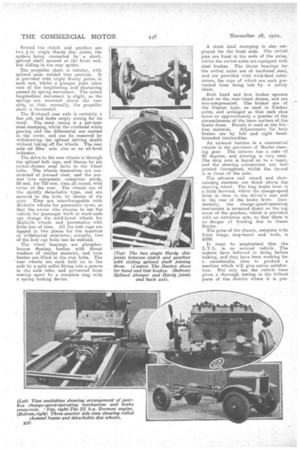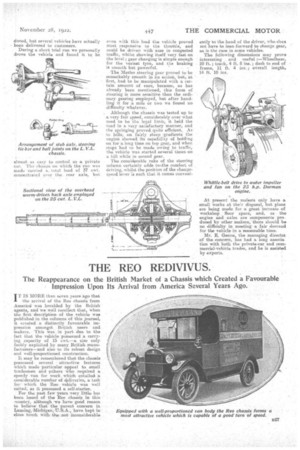A BRITISH 25 CWT. BY A NEW MAKER.
Page 9

Page 10

Page 11

If you've noticed an error in this article please click here to report it so we can fix it.
The L.V.L. Vehicle, Built at Wolverhampton, Embodies a Dorman Engine, Kirkstall Axles, Four-speed Geat box and Rolled Channel Frame.
F'"a new maker to enter the lists of the commercial-vehicle trade at tile present Aims with an entirely new model requires a considerable amount of courage and unbounded confidence in the quality of the product, which trust, ii success is to be achieved, must not be misplaced.
After a searching examination and a short open_ read and traffic test _of the new 14.V.L. chassis of 25-cwt. loadcarrying capacity made by L.V.L. Motor Vehicles, Powiett Street, Wolverhampton, we are certainly greatly inclined to the belief that in it we have found a vehicle which will very soon earn for itself a sound reputation for strength, durability and economy, combined with comparatively light weight.
It Must not be thought that the L.V.L. is a vehicle made up of components hurriedly put together. Both in its appearance and the way in which it is assembled, finish is apparent. For instance, no rivets are used anywhere throughout the-frame, and the bolt. holes are all reamered to size.
The frame itself has rolled channelsteel side-members 4 ins. deep, 2 ins. wide and absolutely straight. it is rather unusual practice to have such a frame on a chassis weighing only 23 cwt., but experience has proved that the rolled channel frame cannot be improved upon, providing that straight side-members can be utilized.
The front engine bearer is of channel section Pressed steel slightly dropped in the centre to take the spherical bearing for the front end of the engine. At the rear the engine is supported by two crankcase) arms carried on cast-steel brackets bolted direct to the sidemembers. The main cross-members, apart from the engine.bearer, consist of two stout tubes situated at the points where the rear springs are fulerumed. Malleable castings are employed for the front dumb-irons. These are given plenty, of supporting area on the frame. The spring brackets are bolted through the frame to. the ends of the crossmembers. The spring fulcrum pins are of three per cent. nickel-chrome steel; they are a fro-fit into the spring brackets, and are additionally held by split-pinned castle nuts.
The four-speed-and-reverse gearbox is four-point suspended from two channelsteel cross-members arranged with the channels upwards and belted to the top of the upper faces of the side-members. The box is of the selector type, giving direct drive on top and total reductions of 11.5 to 1, 16 to 1, 28 to 1 and reverse 27 to 1, whilst the final drive gear ratio is 6.5 to 1. The direct drive on top gear
is through external dogs. The gearshafts are supported at one side on ball bearings, roller bearings being fitted at the side next to the constant-mesh wheels.
We have not yet dealt with the details of the power unit, although we have mentioned that this is a Dorman. It is a four-cylinder L-beaded monobloe of 20 h.p, R.A.C. rating, with the valves at the near side. The cylinder heads are detachable en bloc, and the water outlet to the radiator is at the upper portion of the cylinder head at the front, whilst the inlet is formed as part of the casing of the impeller-type water circulating pump, which is operated by the same Whittle belt that drives the fan. The latter is fourbladed, the blades being of pressed steel and renewable.
The B.T.H. magneto is situated at the near side, and is driven direct from the helical timing gears. At this side of the engine there is also a large and accessible oil filter, whilst the oil filler, which is provided with a quickly detachable cap, is to be found at the off side. Carburation is attended to by an instru ment of Zenith make. To a.scertaia t level of the oil a dipper is provided.
An interesting feature of the chassi. layout is the position of the petrol tank This is cylindrical, and is ensconcee under the bonnet at the off side of the en gine. It. is supported by vertical brackets bolted to the crankcase, and addition-, ally held by clips to the cylinder head. In this position the petrol in the tank is slightly warmed_ by the engine, but never. reaches a temperature approaching danger point, and. it has been proved by experience that this arrangement has greatly decreased the petrol consump, tion, which is guaranteed not to exceed one gallon per 17 miles.
The cast -aluminium header and bottom-tank-type radiator has a neat and prepossessing appearance. It has three rows of spiral-gilled tubes, but provision is made for an extra row if this be required for overseas work; prolonged teats in this country, however, have proved that the three rows give quite satisfactory cooling. Thick, rubber buffers are used to insulate the radiator from shocks. The cap is a neat aluminium casting with a coarse thread, which could not by any chance be crossthread ed.
The drive from the power unit to time gearbox is through a Ferodo-f aced external cone clutch with a pressed steel centre and direct. withdrawal mechanism embodying two ball races. Clutch spinning is prevented by a Ferodo-faced stop, which presses direct on to the cone This stop greatly facilitates gear changing, particularly on hills. Behind the clutch and gearbox are two Fin. single Hardy disc joints, the spiders being connected by a short, -splined shaft secured at the front end, but sliding in the rear spider.
The propeller shaft is tubular, with splined ends welded into. position. It is provided with triple Hardy joints at each end, whilst a plunger joint takes care of the lengthening and shortening caused by spring mce;arneet. The actual longitudinal movement is slight, as the springs are mounted above the rear axle, so that, normally, the propeller shaft is horizontal.
The Kirkstall rear axle is certainly a fine job, and looks amply strong for its work. The main casing is a pot-type steel stamping, whilst the overhead worm gearing and the differential are carried in the cover, and can be removed by withdrawing the splined driving shafts without taking off the wheels. The rear axle oil filler acts also as an oil-level indicator.
The drive to the rear wheels is through the splined huh caps, and thence by six nickel-chrome steel bolts to the wheel hubs. The wheels themselves are constructed of pressed steel, and the normal tyre equipment comprises solids, 8(1 mm, for 720 mm. rims all round, with twins at, the rear. The wheels are of the quickly !detachable type, and are secured to the hubs by means of six nuts. They are interchangeable with Michelin wheels for pneumatic tyres, so that the owner who chooses to use the vehicle for passenger work at week-ends cats change his solid-tyred wheels for Michelin wheels and pneumatics with little lass of time. All the hub cape are tapped in two places for the insertion of withdrawal setscrews; actually, two of the hub cap bolts can be utilized.
The wheel bearings are phosphor. bronzefloating bushes with thrust washers of similar material, and twin bushes are fitted in the rear hubs. The • rear wheels are each held on to the axle by a split collet fitting into a groove in the axle tube, and prevented from coming apart by a complete ring with a spring locking device. A stout steel stamping is also employed for the front axle. The swivel pins are fixed in the ends of the axles, whilst the swivel axles are equipped with steel bushes. The throat bearings for the swivel axles are of hardened steel, and are provided with wick-feed lubricaters, the caps of which are each prevented from being lost by a safety chain.
Both hand and foot brakes operate direct on the rear-wheel drums; and are non-compensated. The brakes are of the Duplex type, as used in Timken axles, and arranged so that each shoe bears on approximately a quarter of the cireurnference of the inner surface of the brake drum. Ferodo is used as the frie
tion material. Adjustments for both brakes are by left and right handthreaded turnbuckles.
An unusual feature in a. commercial vehicle is the provision of Merles steering gear. The column has a rake of 45 degrees, and steering is very easy. The drop arm is keyed on to a taper, and the steering connections are ball jointed throughout, whilst the tie-rod is in front of the axle.
The advance and retard and slowrunruieg controls are fitted above the steering wheel. The long brake lever is a little forward, whilst the change-speed
lever is (Joao to the driver's at and to the rear of the brake lever. Incidentally, the change-speed-operating mechanism is mounted direct on the top cover of the gearbox,which is provided with an extension arm, so that there is no. danger of binding due to -frame flexion.
The price of the chassis, complete with front wings., step-board and tools, is R,595.
It must be emphasized that the L.V.L. is no untried vehicle. The makers have believed in doing before talking, and they have been working for a considerable time to produce a machine which will give entire satisfaction. Not only has the vehicle been given a thorough testing in the hilliest parts of the district where it is pro.
duced, but several vehicles have actually been delivered to customers.
During a short trial run•we personally drove the vehicle arid found it to be even with this load the vehicle proved most responsive to the throttle, and could be driven with ease in congested traffic, whilst showing itself very fast on the /eve ; gear changing is simple enough for the veriest tyro, and the braking is smooth but powerful. .
The .Marles steering gear proved to be remarkably smooth in its action, but; At ' first, had to be manipulated with a certain amount of care, because, as has already been mentioned, this form of steering is more sensitive than the ordi-nary gearing employed, but after handling it for a mile or two we found no difficulty whatever.
. Although the chassis was tested up to a very lair speed, considerably over what used to be the legal limit, it held the road in a very satisfactory manner, and the springing proved, quite efficient. As. to hills. on fairly steep gradients the engine showed its capability of holding on for a long time on top gear, and when stops had to be made owing to traffic, the vehicle was started several 'times on a. hill -while in second gear.
The considerable rake of the steering column certainly adds todhe comfort of driving, whilst the position of the changespeed lever is such that it comes conveni
ently to the hand of the driver, who does not have to lean forward to di-auger gear, as is the case in some vehicles.
The following dimensions may prove interesting and useful :—Wheelbase, 10 ft.; track, 4 ft. 8 ins.; dash to end of frame, 11 ft. 4 ins. ; overall length, 14 ft. 10 ins.
At present the malrers only have a small works at their disposal, but plans are being made for a great increase of workshop . floor space, and, as the engine and axles are components produced by other makers, there should be no difficulty in meeting a fair demand for the vehicle in a reasonable time,
Mr. E. Genna, the managing directot of the concern, has had a long associa tion with both the private-car and commercial-vehicle trades, and he is assisted by experts.




























